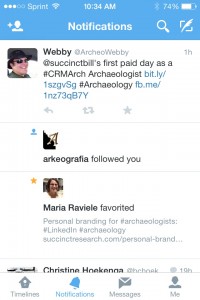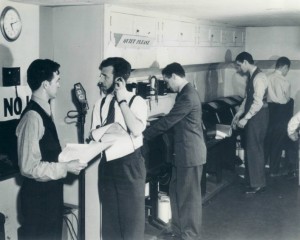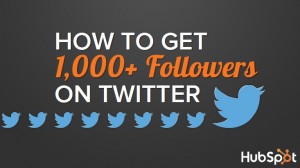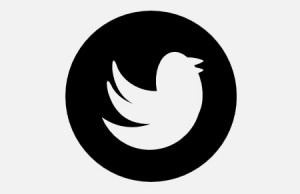(This is the third post in a multi-part series on personal branding for archaeologists. In case you missed it, Part I covered some reasons why it’s important to control your online professional persona and Part II discussed how you can use LinkedIn to demonstrate your skills, abilities, and experience as an archaeologist. This is the definitive guide to personal branding on Twitter for archaeology professionals.)
 Here’s a recent Twitter message, also known as a “Tweet”, that one of my good friends Chris Webster recently wrote about a guest post I wrote for his website:
Here’s a recent Twitter message, also known as a “Tweet”, that one of my good friends Chris Webster recently wrote about a guest post I wrote for his website:
“@succinctbill’s first paid day as a #CRMArch Archaeologist bit.ly/1szgvSg #Archaeology fb.me/1nz73QB7Y”
If you don’t use Twitter, you’re probably thinking: “What??! What the hell does that mean? What does that random number sign and the “at-sign” mean? I can sorta understand part of the message but why is it written in such ridiculous prose?”
Twitter does have a language of its own that non-Twitter users may be turned off by, especially if you’re a prim-and-proper, college-educated archaeology type. Punctuation and grammar are low on the totem pole of importance on Twitter. Also, the co-option of the number sign (AKA hashtag) and ‘at-sign’ (@) have particular use and importance on Twitter that doesn’t jive with the way they’re used in vernacular English.
But, Twitter is more than learning some hipster linguistic code. It’s about reaching out to other people that share your same interests, connecting with them by sharing information, and participating in an online community with people you’ve never met in the real world.
Despite its quirkiness, Twitter is an excellent way to connect with other archaeologists and archaeology fans around the world. In his book “Jab, Jab, Jab, Right Hook”, Gary Vaynerchuk compares Twitter to the mingling conversation at a cocktail party. Except, on Twitter, the conversation continues going on day and night, all over the world. Engagement is at the heart of Twitter because the platform’s users have to continue contributing to the conversation in order to stay afloat among the 24-7 conversation that’s going on. “…[I]f there has ever been a platform where engagement and community management have power, it’s this one” (Vaynerchuk 2013:85).
The power of interconnectivity that Twitter enables has been demonstrated in a number of ways. A recent example is the swift action taken by the archaeology community to “delay” the airing of the insidious show “Nazi War Hunters” on the National Geographic channel. I’ve discussed this on this blog post and this one. In a nutshell, the show depicted World War II memorabilia collectors and archaeological site looters digging through eastern European battlefields in search of war miscellanea that could be sold for a profit donated to a museum. The show’s promo showed non-archaeologists digging up human remains and desecrating battlefield burials for viewers at home.
Obviously, this show had a lot of flaws and complaints on Twitter weren’t the only thing that stopped the show from airing. Letters to the editor in newspapers-of-record like the New York Times, a proliferation of blog posts, and protests from some of the largest archaeological professional associations did much to stop the show from going live. But Twitter was one of the main platforms where archaeologists around the world connected for a common cause. This coordination for the cause was made easier because of the specific coded phases that Twitter is so famous for. In this instance, hashtagged phrases such as #naziwarhunters and ‘at-signed’ Twitter handles like @NatGeo made it easier for archaeologists to seek out like-minded individuals that would help get the show cancelled. Hashtagged phrases are also picked up by search engines like Google, which made it even easier to read up on the campaign to end the show. In the end, the conversation and engagement by archaeologists and archaeology fans who rose up against the show on NatGeo was made much more effective because of Twitter.
This post on how you can leverage Twitter to help build your personal brand is the third installment in a series I’ve been writing throughout July and into August. The idea for this series came from a webinar I attended called “How to Build your Personal Brand Online”. The webinar was sponsored by the Human Resources Department at the University of Arizona and was presented by Jaynelle Ramon and Christine Hoekenga, two of the skilled social media coordinators at UArizona. I discussed their credentials in the first post of this series, which you can check out here.
Ramon and Hoekenga had a number of great tips on how you can use Twitter and, as I did in Part I and Part II of this series, I’ve taken the liberty to add my perspective as an archaeologist.
Tweets aren’t Just for the Birds
You probably know that Twitter is a social media platform. Here are some other things about Twitter I thought you’d like to know:
— Messages on Twitter, called tweets, are limited to 140 characters.
— It was launched in 2006 and had over 500 million users worldwide by 2013.
— In the United States there were over 100 million users in 2013, so Twitter is truly an international platform.
— It is the world’s most popular micro-blogging platform. Users post 750 tweets per second!
— Conversations are happening in real time, which means your news feed is constantly unfolding.
— Most users are Millennials. Data collected in 2012 (http://www.beevolve.com/twitter-statistics/#a2) indicated nearly 74% of Twitter users were between 15 and 25 years old and almost 15% of users were 26 to 35 years old, which suggests nearly approximately 89% of users are young adults.
— Slightly more than half of all users (53%) are women.
— About 81% of users have 50 or fewer followers and are following fewer than 50 other individuals.
— Family and education are the most popular topics for users between 15 and 35 years old.
Most importantly: Twitter is primarily used on mobile devices. This means messages and conversations on this platform need to be optimized for people that are on the go (either in their cars, waiting rooms, the bathroom, and anywhere except for sitting behind a desk), which means your message can and must be broadcast in such a way that people can check it out while they’re on the go.
Twitter Basics for Personal Branding
Ramon and Hoekenga had some excellent tips for using Twitter to build your personal brand. The key is to leverage the way the platform allows you to indiscriminately reach out to like-minded people in order to expand your network far and wide. Unlike Facebook and LinkedIn, Twitter allows you to “follow” people you don’t already know which means you can read and comment on their messages even if you don’t have any real-world connection to them. This is totally a plus because you can make your own introduction to role models without needing a prior connection. You can also use similar interests, as conveyed through hashtagged phrases, in order to connect with others and create a focused peer group.
While it’s possible to reach out anonymously, you need to understand how this social media platform works if you really want to connect with others in a meaningful way. Remember, most users were born between 1979 and 1999 and they’ve been inundated with commercials and advertisements for their entire lives. We loathe commercials. We can smell an ad from a mile away and, if you’re messages are too self-centered, too “lookie at what I’ve done”, we’ll drop you from the conversation. Twitter is about conversations and nobody likes it when someone spends the whole time talking about themselves. Vaynerchuk calls it Birdiebragging, which is another form of bragging that nobody likes. Share. Contribute. Converse. And, you’ll have no problem connecting in a meaningful way.
Here’s what Ramon, Hoekenga, and I have to say about Twitter:
— It’s a great way to stay current— Because the conversation is always unfolding, Twitter is a sweet way to hear about the current goings-on in archaeology.
— Use hashtags but don’t go overboard— Hashtagged phrases and word are Twitter’s currency. Use unique, memorable hashtags so others can hear your voice among the crowd. You can also use common hastags to your advantage. For archaeologists, there are several hashtags we use frequently including #archaeology, #CRMarch, #freearchaeology, #historicpreservation, and #histpres. The goal is to use hashtags so you can stay relevant in the conversations about these topics because Twitter users search for tweets on these topics based on their hashtags. Also, you only have 140 characters so you need to use easily identifiable hashtags to keep your tweets relevant.
However, using too many hashtags can make your message too disjointed, unoriginal, and insincere. Other users don’t want to retweet a tweet stuffed with hashtags because there’s no content in these. They’re sloppy attempts at trendjacking; i.e. a shitty commercial, and nobody wants to pass that message along (more on the Art of Trendjacking later in this post).
— Use less than the minimum— The most retweetable tweets use less than the 140-character limit. You need to leave a little room in each tweet so your followers can add a short statement when they retweet you. I aim for only 100 to 110 characters in my tweets, including the URL.
— Engage and converse with others— This can’t be overstated. You should use the 24-7 newsfeed to enter into the conversations that are going down and help them continue. Feel free to re-tweet and “favorite” others’ tweets. Respond when others retweet or comment on your tweets. Thank those that decide to follow you. Politeness and reciprocity goes a long way on Twitter.
— Link to the internet— You don’t have too many characters on Twitter, but you need to make sure to frequently insert relevant links to online content in your tweets. This allows you to connect your short messages on the platform to the larger universe of the internet. Don’t worry about inserting long URL. Twitter automatically has a URL shortener so the link can better fit in the 140 character limit.
— Connect with industry leaders— Twitter allows you to connect with archaeology leaders in several ways. You can follow their Twitter handle (it’s the name they use on the platform that has an “at sign” in front of it. For instance, my handle is @succinctbill). You can also help further their conversations by re-tweeting their tweets. Or, you can be bold and offer your honest opinion of their tweets.
If you link first and keep posting relevant content, these industry leaders may just end up following you. I can’t tell you how happy I was when Paul Mullins (@mullins_paul) and Timothy Pauketat (@TPauketat) followed me.
— Promote yourself— Self-promotion is at the heart of personal branding. Twitter is a great way to spread the word about archaeology projects, articles, books, and other archaeology-specific topics in such a way that it adds to your online persona. For example, if you’ve just heard an awesome archaeology discussion by a famous archaeo, you can send out some tweets with the discussant’s Twitter handle (if they have one) with a couple relevant hashtags. These hashtagged tweets will help connect you to archaeology, which helps build your brand as an archaeologist.
While you can use the platform to spread the message about yourself, be careful to not brag about yourself too much. Make sure most of your tweets are passing on the word about someone else and not just focused on what you’re doing and what you like. Birdiebragging is offensive. Twitter rewards people who listen and give back, not those that ask for things and take up other people’s time.
— Be sincere— This is the number one most important thing to know about having a Twitter presence. Be yourself. Use tweets to tell the world about things you like and to give your own personal take on events. People under 35 years old can smell deceit, so don’t be a faker. It’s easy to make your life look like roses and chocolates on other social media (Facebook, your personal website, your blog, ect.), but in the constantly evolving world of Twitter, the people that are only talking about how great they are will be drown out and forgotten. Twitter is where you can add your two cents and connect with anyone who will listen.
Moving Past the 80th Percentile and Becoming your Own Brand Advocate
As I mentioned before, just over 80% of Twitter users have <50 followers and follow <50 others. There are thousands of other archaeologists on Twitter, but, if these calculations are correct, most of us aren’t really participating in the conversations because we have so few followers and follow so few others. There are several ways you can move beyond the 80th percentile and become a branded advocate on Twitter. My personal goal is to surpass 1,000 followers, which is really commendable for someone that’s branding himself as an archaeologist on Twitter and isn’t a university professor.
The following info comes from personal experience, the webinar by Ramon and Hoekenga, dozens of blog posts, and a few select books including the following:
HubSpot, Inc.
n.d How to Get 1,000 Followers on Twitter. (http://offers.hubspot.com/grow-your-twitter-followers-fast) HubSpot, Inc., Cambridge, MA.
SocialChorus
2013 Millennials as Brand Advocates: What you need to know to engage the Most Important Consumer Generation. (http://www.socialchorus.com/resources/millennials-as-brand-advocates/) SocialChorus, San Francisco.
Vaynerchuk, Gary
2013 Jab, Jab, Jab, Right Hook: How to Tell your Story in a Noisy Social World. HarperCollins, New York.
(Full Disclosure: The eBooks with URLs are available for free download. I’m not getting a kickback for recommending them, but I really need to think about being an affiliate of their products because I truly endorse them.)
1) Create a professional-looking profile— As is the case with LinkedIn, you need to look professional if you’re branding yourself as a professional. Your personal brand will be conveyed through your cover image, avatar, personal bio, and backlink to your LinkedIn profile or personal website.
Since you’re trying to convey the message that you’re a professional archaeologist, you’re going to need to use a cover image that demonstrates that message in a sensitive way (BTW: The cover image is the picture behind your avatar [The avatar is the headshot of yourself that shows up next to your Twitter handle]). Don’t use a cover image that shows you excavating a skeleton somewhere or shaking hands with a Native American dressed in powwow gear. Its good form to use a cover image that conveys the image of a professional archaeologist without being too cliché.
Some people recommend using a custom background, but I feel like this can make your personal profile look too busy. Nothing is more distracting than a bunch of gaudy fleur-de-lis doodles scrolling on the side of the screen whenever people look at your Twitter profile.
Also, use an avatar photo that shows your face because this is a way you can link with your Twitter activity in real life. You want people to be able to associate with the identity you’ve carefully crafted on Twitter by recognizing your face at a conference or meeting. That can’t be done if your avatar is a cartoon trowel or fluffy kitty pic.
No matter what avatar picture you use, make sure people can clearly see your face or whatever it is that you’re doing. This goes for all photos on Twitter: make sure people can clearly see what you’re trying to show them. Use a high quality photo that is focused on the thing(s) you’re trying to show. Remember, people are primarily using Twitter on their phone so a small avatar pic is made even smaller on a mobile device.
2) Write a great bio— You only have 140 characters, but make sure you describe who you are and what you do in a succinct way. Make sure to use keywords that target the personal brand you’re after. I’m not saying my bio is the best, but it’s short and to-the-point which is what Twitter is all about. Check it out: https://twitter.com/SuccinctBill
3) Just keep tweeting— You will need to stay active on Twitter if you want to stay relevant. This can be as easy or as hard as you want it to be. Because Twitter is constantly scrolling in real-time, you can reach a wider audience if you tweet a lot because your tweets, retweets, and comments will be at the top of your followers’ news feeds. This can eat up a lot of time if you’re not strategic about it.
The easiest way to stay relevant on Twitter is to tweet and re-tweet at the times of the day when Twitter users are most active. I’ve seen all kinds of blog posts about when users are most active, but I’ve realized most people are skimming the platform when they wake up in the morning (6—7 A.M.), when they’re on their way to work (around 8 A.M.), during lunch (around Noon), on the way home from work (5ish P.M.), and when they’re in bed before going to sleep (10ish P.M.). You can stay at the top of the news feed if you tweet and retweet content at these times.
Think about it, when are you most likely to be skimming your social media feeds? Probably intermittently throughout the day, but you’re most likely checking out Facebook, Pinterest, and Twitter when you’ve got some down time— like when you’re driving to and from work and when you’re lying in bed underneath the covers. It’s not rocket science. Either tweet hundreds of times a day or tweet when most people are listening.
4) Go to a Tweetup— Sending little messages back and forth on the internet is great, but sometimes you actually want to meet some of your Twitter followers in person. Tweetups are real-life meet-ups between Twitter followers. They’re a great way to meet people that have similar connections and interests as you do.
The first tweetup I attended was at SHA2014 in Austin. At first, I was intimidated by meeting these folks that I’d been tweeting with for months because I was worried that I wouldn’t meet their expectations or would say/do something embarrassing. It was a great experience. Tweetups are much better than a first date or going to a “networking event” because you are not meeting people without some prior interaction. It’s not a cold call because you’ve already been messaging each other before you met them in real life. I ended up having a great time and solidifying relationships that were first nurtured online.
It may take a while on Twitter before you have the opportunity to attend a tweetup. Don’t worry about meeting people you know from Twitter that you haven’t “met” before. It’s a lot less painful than you think it will be. And, you will probably have a lot of fun while linking your online persona to a real person.
Twitter Master Tips for Archaeologists
Okay, okay. I’ve explained the basics of how Twitter works and what you’ve got to do to get into the 80th percentile. But, if you want to go the extra mile and build your online brand as an archaeologist you’re going to need to do even more than that. Here are some tips from social media professionals and my own personal experience that you can use to make Twitter more manageable:
A) Target your message— You are trying to build a personal brand, which means you’re going to have to target a specific message that tells the world about who you are, what you do, and your personal ethos for your profession. Search engines make this easy because you can target keywords in your tweets so that they’re connected to your name and social media accounts. The key is to liberally use hashtags. I want the world to know I’m an archaeologist, so I’ve targeted keywords/hashtags related to archaeology in my tweets. This makes it easier for search engines and other archaeologists to find me when they look for archaeology related topics online.
B) Find relevant content created by others— Conversation is how Twitter works. This means you benefit by tweeting about the discoveries, articles, and blog posts created by other archaeologists as much as you do from archaeology-related content you’ve created.
Once again, search engines and social media platforms make it easy to find archaeology content to tweet about. One of the best ways to get tweetable information automatically sent to you is by creating a Google Alert for specific keywords delivered to your email inbox. I have alerts for archaeology, historic preservation, and cultural resource management sent to my email account every day. This gives me an endless supply of online newspaper articles and blog posts that I can share with my followers.
You can also search Twitter itself for trending tweets about archaeology and other topics by using the Twitter search function. Other excellent content wells include: feedly, StumbleUpon, and GoodReads. Integrating your other social media accounts with Twitter is also easy. Feel free to tweet about content from Facebook, LinkedIn, and Google+, especially if it’s content you’ve posted there.
C) Automate your content posting— Here’s a secret: You don’t have to tweet all day long. You can automate your tweets so they’ll post when and where you want.
There are a bunch of automated social media systems out there, but I use HootSuite for several reasons. Mainly because it’s free. HootSuite also allows me to schedule my posts to multiple social media accounts using an easy and accessible desktop. I typically spend about 2 hours a week scheduling posts on Twitter, LinkedIn, and Google+. It wouldn’t be much more effort to post on other social media accounts, but I like learning how each social media platform really works and I’m not quite ready to expand beyond those three (However, I am considering Pinterest. Can any of y’all show me a quality tutorial on that platform). Scheduling tweets is an excellent way to maintain your presence on Twitter and other social media platforms with minimal effort.
D) Use quality photos— Research has shown that tweets with awesome photos have a much higher response rate than tweets that are simply text. As archaeologists, we are particularly well-positioned to create bad ass photo tweets because of where we work, who we are, and what we work with. A photo tweet of a haboob encountered while working in the Sonoran Desert or a porcelain doll head excavated from a privy in St. Louis would get passed around further than if we just wrote about these encounters.
There are some words of caution about using photos in archaeology tweets. First, make sure you don’t offend someone. I always think social media photos of human remains are inappropriate and disrespectful (even if you’re a bioarchaeologist). Second, don’t lose your job over it. Spreading photos of working at clandestine locations can get you fired. I have a friend that was fired for using social media while working on a mine site in Nevada. It can happen. (Learn more about how to not get fired while using social media by reading Chris Webster’s chapter in the FREE eBook Blogging Archaeology. Download it for free here.) Third, don’t give any information that looters could use to destroy sites. Do not tweet photos that could give away a site location.
E) Make your message authentic— Most people use social media to add to a specific image that they’ve created for themselves. Research has shown that the personal image people create using social media is authentic and remarkably similar to the personal image they use in real life. Even though people could be anything they want to be on the internet, most individuals use social media to reflect the reality of who they actually are.
Why do this? If you could be anyone you wanted to be, why would you choose to be yourself?
Because people are using the internet to create sincere connections with other human beings. We’re comparatively honest on social media because we have the desire to honestly connect with other people.
Now, I’m sure anyone who has used a dating website would differ with this determination. But, it has been my experience that when I meet people that I’ve previously connected with on social media they look and act similar to how they behave on their social media accounts.
In order to participate in Twitter conversations in a meaningful way, you are going to have to stay true to yourself. Your tweets need to be authentic and honest because there is a whole lot of marketing and Birdiebragging going on. Authentic, sincere interaction cuts through this noise like a trowel through silty loam.
An Introduction to Trendjacking
You’ve probably never heard of trendjacking. I hadn’t either before I read Vaynerchuk’s most recent book (2013:88—89, 90—92). Trendjacking is the art of using hashtags related to trending topics in popular culture to extend your message to a wider audience. Expanding beyond archaeologists and archaeology fans is important because it extends your message to followers that may not necessarily listen to you. It also injects new content into your current following, which is probably quite insular because archaeologists tend to listen to, relate to, and befriend other archaeologists. Trendjacking gives you the capability to, “…piggy-back on other people’s content, giving you a reprieve from having to think up fresh creative [stuff] day after day. You’ll still put out original content, but in this case, your content is the context you use to tell your story” (Vaynerchuk 2013:88). For the purposes of this blog post, telling your story is synonymous to conveying your brand.
I’m still a novice at this, but I have recently gained quite a few additional followers and increased interaction with my tweets by infusing them with popular hashtags. Most of my tweets get few retweets and favorites, but I have seen increased interaction when I started using trending, non-archaeology related hashtags. The jury is still out on this one; however, it does appear to be increasing my followers and participation in conversations beyond archaeology.
How does Tweeting Increase your Personal Brand?
I can think of several ways:
— It allows you to connect with other archaeologists, including ones you’ve never met.
— You can keep up with current events in real-time.
— It allows you to participate in conversations in an authentic, yet, succinct way.
— The 140-character limit forces you to stay on topic and use unique, followable hashtags.
— You can engage and converse with industry leaders.
— You can expand beyond the insular universe of archaeologists and archaeology fans.
The benefit of Twitter is it allows you to connect with real-time, quick-fire conversations and exchange ideas with others. You can use the constant, 24-hour news feed to participate in communities of other young professionals. Brevity is one of its strengths because you don’t get a chance to bore your followers with archaeospeak. You have to stay to the point and direct traffic to other places where you’ve gone in depth (such as this 4,600-word blog post). Importantly, Twitter has the potential for engagement and community building unlike other social media platforms. We can use it to spread the truth about archaeology in a way that simply isn’t available on Facebook, LinkedIn, or Pinterest.
Twitter is my favorite social media platform. There are some fluffy cat photos, but there’s a lot more discussion about topics in my professional interest.
Do you plan on building your brand on Twitter? Do you want to connect with other archaeologists through this blog? If so, send me an email or write a comment below with your twitter handle. You can also tweet me: @succinctbill
Seriously, write a comment below or send me an email.
Check out Succinct Research’s most recent publication Blogging Archaeology. Full of amazing information about how blogging is revolutionizing archaeology publishing. For a limited time you can GRAB A COPY FOR FREE!!!! Click Here
 “Resume-Writing for Archaeologists” is now available on Amazon.com. Click Here and get detailed instructions on how you can land a job in CRM archaeology today!
“Resume-Writing for Archaeologists” is now available on Amazon.com. Click Here and get detailed instructions on how you can land a job in CRM archaeology today!
 Small Archaeology Project Management is now on the Kindle Store. Over 300 copies were sold in the first month! Click Here and see what the buzz is all about.
Small Archaeology Project Management is now on the Kindle Store. Over 300 copies were sold in the first month! Click Here and see what the buzz is all about.
Join the Succinct Research email list and receive additional information on the CRM and heritage conservation field.
Get killer information about the CRM archaeology industry and historic preservation.







